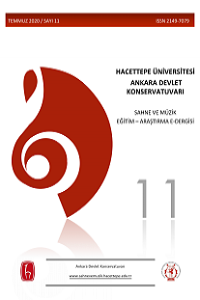Öz
Flute, because of its unique mouthpiece, has the most air requirement within the wind instruments. In order to play it in a correct way, the flute player needs to understand two subjects. First one is an in-depth knowledge of how human respiratory system works and second one is powerful abdominal muscles.
Most of the organs related to respiratory system are invisible from outside. This causes a lot of misinformation about how it works and making the subject hard to understand. Breathing capacity will be increased by periodic exercises, hence musical sentences will be played easily without any interruption.
In this article, details of the aforementioned subjects will be touched. Also; flute modernization process, anatomical knowledge of the respiratory system and breathing technic (and how to enhance it) are mentioned.
The purpose of this article is to stress the importance of the breath technique and explain exercises those need to be done in order to improve it.
Anahtar Kelimeler
Kaynakça
- Boehm, T. (2011) The Flute and Flute-Playing in Acoustical and Artistic Aspects. New York: Dover Publications, Inc
- Bouhuys A.(1968) Pressure Flow Events During Wind Instrument Playing. Annals of New York Academy of Sciences Volume 155, Issue 1, 264-275. 11.06.2020, https://nyaspubs.onlinelibrary.wiley.com/doi/abs/10.1111/j.1749-6632.1968.tb56771.x
- Chapman, Janice, L.(2017) Singing and Teaching Singing. (Third Edition) California:Plural Publishing Inc.
- Collins, Paul. (2008) Awesome Abs. UK: Meyer & Meyer Sport
- Collwell Richard J.,Hewitt Michael P. (2016) The Teaching of Instrumental Music.(4th Edition) New York: Routledge
- Debost, M. (2002) The Simple Flute From A to Z. New York: Oxford University Press
- James, George A. (2012) Abdominal Training Inside And Out. USA:Xlibris Corporation
- Kartal, M. (2009) Konuşmacılar ve Şarkıcılar İçin Ses Teknikleri.İstanbul: Sistem Yayıncılık
- Maclagan, Susan J. (2019) A Dictionary For The Modern Flutist. (Second Edition) London: Rowman & Littlefield
- Mills, J.N. (1949) Variability of The Vital Capasity of The Normal Human Subject.
- The Journal of Physiology 110 (1-2),76-82. 11.06.2020 https://www.ncbi.nlm.nih.gov/pmc/articles/PMC1392774/
- Netter, F.H.(2005) İnsan Anatomisi Atlası.(Prof. Dr. Meserret Cumhur Çev.) İstanbul: Nobel Tıp Kitabevleri
- Pilafian, S.,Sheridan, P.(2002) The Breathing Gym. USA: Focus On Excellence
- Rainey,(Jr.) T.E. (1988) The Flute Manual. New Wilmington: Son-Rise
- Taşer, S. (1987) Konuşma Eğitimi. Ankara: Dost Kitabevi Yayınları
- Toff, N. (1996) The Flute Book. New York: Oxford Universty Press
- Ünsal, F., Şahin H. (2008) Seksen Yılın Sesi 1927’den 2007’ye Spikerlik. Ankara: Trt Genel Sekreterlik Basım ve Yayın Müdürlüğü Ofset Tesisleri
- Wye, Trevor (1980) Practice Books for the Flute. (Omnibus Edition Books 1-5) London: Novello
- 20.03.2020, http://www.yenibiyoloji.com/soluk-alip-verme-konu-anlatimi-2024/
- 08.06.2020, https://jennifercluff.blogspot.com/2012/01/teaching-breathing-easily.html?=1
- 08.06.2020, https://www.jennifercluff.com/breathe.htm
- 10.06.2020,http://clarinet-saxophone.asn.au/wp-content/uploads/The-Dynamics-of-Breathing.pdf
- 10.06.2020,https://www.windsongpress.com/product/breath-builder/
- 10.06.2020,https://www.youtube.com/watch?v=c8RTdhdGDWo
- 10.06.2020,https://www.youtube.com/watch?v=bfX60Iokon0
- 10.06.2020,http://www.blockiflute.com/Pneumo-ProDVD-Kit_p_37.html
- 11.06.2020, http://kimballtrombone.com/breathing/respiratory-training-for-musicians/
- Turgay, H.H., (2010). Öğretim Üyesi, Ankara Müzik ve Güzel Sanatlar Üniversitesi
- Baxtresser, J., Rearick, M.(1995) Orchestral Excerpts For Flute. Pennsylvania: Theodore Presser Company
- Handel,G.F. (1995) Elf Sonaten für Flöte und Basso Continuo. Germany: Barenreiter Urtext
- Morris,G. (2003) Flute Technique Great Britan: Oxford University Press
Öz
Flüt üflemeli çalgılar arasında ağızlığın yapısı sebebiyle en fazla havaya ihtiyaç duyulan çalgıdır. Bu çalgıyı doğru bir şekilde çalabilmek için iki konunun iyi anlaşılması gereklidir: Birincisi, solunum sisteminin nasıl çalıştığını öğrenmek, ikincisi de karın bölgesindeki kasları kuvvetlendirmektir.
Solunumla ilgili organların çoğunun vücudun içinde yer alması ve görünmemesi, solunum sisteminin doğru bir biçimde algılanmasını güçleştirmektedir. Nefes tekniği konusunda yapılacak olan düzenli çalışmalar doğrultusunda kapasiteyi geliştirmek mümkündür. Böylelikle müzikal cümleler bölünmeden kolaylıkla icra edilecektir.
Bu makalede flütün modernleşme sürecine kısaca değinilmiş, solunum sistemi ile ilgili anatomik bilgi özet bir şekilde verilmiş, nefes tekniği hakkında detaylı bilgiler paylaşılmış ve bu konuyu geliştirmeye yönelik çeşitli alıştırmalar önerilmiştir.
Makalenin yazılmasındaki amaç, flüt çalma sanatında nefes tekniğinin önemine dikkat çekmek ve bu tekniği geliştirmek için yapılması gereken çalışmaları açıklamaktır.
Anahtar Kelimeler
Kaynakça
- Boehm, T. (2011) The Flute and Flute-Playing in Acoustical and Artistic Aspects. New York: Dover Publications, Inc
- Bouhuys A.(1968) Pressure Flow Events During Wind Instrument Playing. Annals of New York Academy of Sciences Volume 155, Issue 1, 264-275. 11.06.2020, https://nyaspubs.onlinelibrary.wiley.com/doi/abs/10.1111/j.1749-6632.1968.tb56771.x
- Chapman, Janice, L.(2017) Singing and Teaching Singing. (Third Edition) California:Plural Publishing Inc.
- Collins, Paul. (2008) Awesome Abs. UK: Meyer & Meyer Sport
- Collwell Richard J.,Hewitt Michael P. (2016) The Teaching of Instrumental Music.(4th Edition) New York: Routledge
- Debost, M. (2002) The Simple Flute From A to Z. New York: Oxford University Press
- James, George A. (2012) Abdominal Training Inside And Out. USA:Xlibris Corporation
- Kartal, M. (2009) Konuşmacılar ve Şarkıcılar İçin Ses Teknikleri.İstanbul: Sistem Yayıncılık
- Maclagan, Susan J. (2019) A Dictionary For The Modern Flutist. (Second Edition) London: Rowman & Littlefield
- Mills, J.N. (1949) Variability of The Vital Capasity of The Normal Human Subject.
- The Journal of Physiology 110 (1-2),76-82. 11.06.2020 https://www.ncbi.nlm.nih.gov/pmc/articles/PMC1392774/
- Netter, F.H.(2005) İnsan Anatomisi Atlası.(Prof. Dr. Meserret Cumhur Çev.) İstanbul: Nobel Tıp Kitabevleri
- Pilafian, S.,Sheridan, P.(2002) The Breathing Gym. USA: Focus On Excellence
- Rainey,(Jr.) T.E. (1988) The Flute Manual. New Wilmington: Son-Rise
- Taşer, S. (1987) Konuşma Eğitimi. Ankara: Dost Kitabevi Yayınları
- Toff, N. (1996) The Flute Book. New York: Oxford Universty Press
- Ünsal, F., Şahin H. (2008) Seksen Yılın Sesi 1927’den 2007’ye Spikerlik. Ankara: Trt Genel Sekreterlik Basım ve Yayın Müdürlüğü Ofset Tesisleri
- Wye, Trevor (1980) Practice Books for the Flute. (Omnibus Edition Books 1-5) London: Novello
- 20.03.2020, http://www.yenibiyoloji.com/soluk-alip-verme-konu-anlatimi-2024/
- 08.06.2020, https://jennifercluff.blogspot.com/2012/01/teaching-breathing-easily.html?=1
- 08.06.2020, https://www.jennifercluff.com/breathe.htm
- 10.06.2020,http://clarinet-saxophone.asn.au/wp-content/uploads/The-Dynamics-of-Breathing.pdf
- 10.06.2020,https://www.windsongpress.com/product/breath-builder/
- 10.06.2020,https://www.youtube.com/watch?v=c8RTdhdGDWo
- 10.06.2020,https://www.youtube.com/watch?v=bfX60Iokon0
- 10.06.2020,http://www.blockiflute.com/Pneumo-ProDVD-Kit_p_37.html
- 11.06.2020, http://kimballtrombone.com/breathing/respiratory-training-for-musicians/
- Turgay, H.H., (2010). Öğretim Üyesi, Ankara Müzik ve Güzel Sanatlar Üniversitesi
- Baxtresser, J., Rearick, M.(1995) Orchestral Excerpts For Flute. Pennsylvania: Theodore Presser Company
- Handel,G.F. (1995) Elf Sonaten für Flöte und Basso Continuo. Germany: Barenreiter Urtext
- Morris,G. (2003) Flute Technique Great Britan: Oxford University Press
Ayrıntılar
| Birincil Dil | Türkçe |
|---|---|
| Bölüm | Makaleler |
| Yazarlar | |
| Yayımlanma Tarihi | 20 Temmuz 2020 |
| Yayımlandığı Sayı | Yıl 2020 Sayı: 11 |


